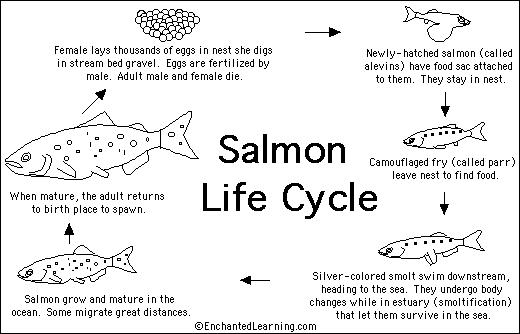
 |
| You might also like: | Taiga Animal Pages to Color Online | Match the Syllables: Fish Words | Bony Fish Printouts | Mosquito Life Cycle Sequencing Cards | Lake Trout Printout | Today's featured page: Leaf Tracing/Cutting Template |
| EnchantedLearning.com More Fish Printouts | EnchantedLearning.com Salmon | Animal Printouts Label Me! Printouts |


Salmon are anadromous fish - they live in the sea but reproduce in fresh water (in a stream or lake). They are amazing fish that live in fresh water during their early life, mature in salt water, and then return to fresh water to breed (and then die). Some salmon (sockeye and chinooks) travel up to 1,000 miles (1,600 km) upstream in order to spawn.
Life Cycle:
Reproduction: Salmon live most of their life in the sea, but when they are mature and ready to breed, they enter fresh water to spawn (reproduce), traveling to a stream or pond high in oxygen. The female digs a nest in the gravel (called a redd) with her tail. She then pushes her thousands of eggs into the nest and the male milks the eggs, fertilizing them. Most salmon die after spawning.
The Eggs Hatch and Grow: The newly-emerged salmon (called alevins) still have a food sac attached to them. When the food sac is used up, the salmon fry emerges from the nest - and must find food (like insects) for the first time. As the fry matures, it becomes camouflaged (with parr marks) and is called parr . When it becomes silver-colored, it will be called a smolt. After growing for a while, the smolts swim downstream to the sea.
Adapting to Salt Water: When smolt reach the estuary (where the river meets the sea), a process begins in which their body changes, allowing them to soon live in salt water (this is called smoltification).
Maturing at Sea, then Returning Home: The salmon lives in the sea until maturity (1 to 7 years, depending on the species); some migrate thousands of miles in the sea. They then return to the place where they hatched and continue the cycle. No one knows how salmon return home -perhaps they remember the distinctive set of smells along the way. On their journey home, they do not eat at all, they often change color, their muscles soften, and they will die soon after spawning.
Anatomy: Salmons have silvery skin with spotted back and fins. The biggest salmon is the chinook, which weighs up to 120 pounds (55 kg).
Diet: Salmon are carnivores (flesh eaters) - they eat fish (like herring and pilchard), squid, and crustaceans (like shrimp).
Predators: Salmon are preyed upon by many animals, including bears, people, many birds (like wading birds and kingfishers), and other fish. For every 8000 eggs produced, 4500 alevin survive, from which 650 fry survive, from which 200 parr survive, from which 50 smolt survive, from which only 2 spawning adults survive (who produce thousands of eggs).
Classification: Kingdom Animalia, Phylum Chordata, Class Osteichthyes (bony fish), Family Salmonidae (salmon, trout, and char), Genus Salmo (Atlantic salmon - salmo means jumper) and Genus Oncorhynchus (Pacific salmon - 5 species; Oncorhynchus means "hooked snout").
Questions:
1. Do salmon hatch in salt water or fresh water? __________________
2. After maturing enough to swim well, does the young salmon swim upstream or downstream? _______________________
3. What is the name of the area where a river meets the sea (and where salmon undergo body changes that let them live in salt water)? _______________________________
4. Where do salmon live until they are mature and ready to reproduce? ____________________
5. What sense do scientists think that salmon use to return to their birthplace? _________________
| Search the Enchanted Learning website for: |